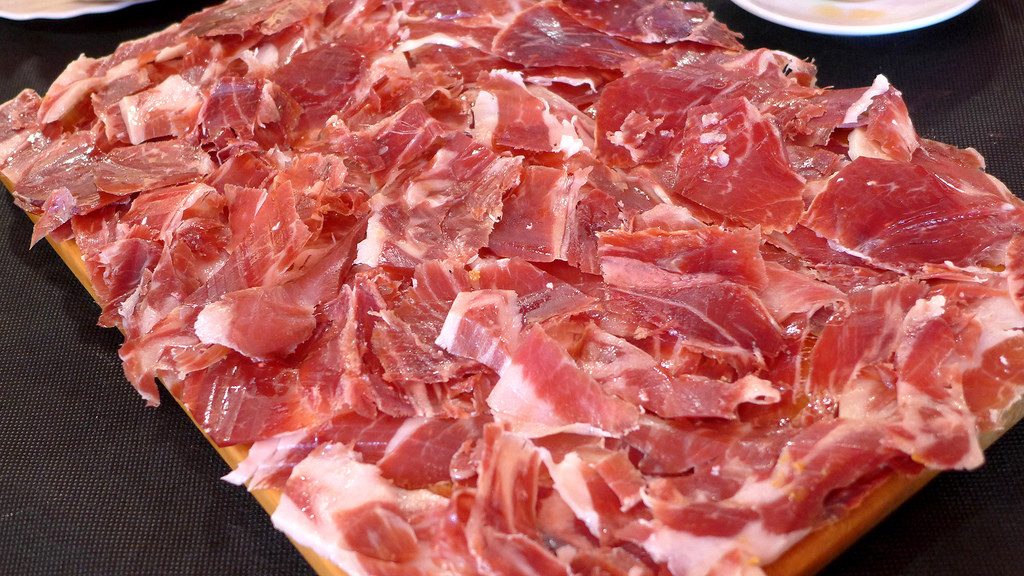Iberian ham, in Spanish “jamón ibérico”, is a type of ham from the Iberian pig, very appreciated in the cuisine of Spain and Portugal, and often considered as an article of haute cuisine and gastronomic luxury.
For its production Iberian ham must have at least 50% purity of this breed to be called «Iberian ham». Although the highest quality will be 100% Iberian hams from Iberian pigs in which both parents will be of race 100% Iberian. For the rest of the Iberian hams, crosses with the Duroc pig breed are allowed. The main characteristics that distinguish the Iberian hams in their quality derive from the purity of the breed of the animals, from the breeding in an extensive regime of freedom of the Iberian pig in wooded pastures where they can move widely and perform physical exercise, of the food that follows the pork in the” montanera” period(period between October and February in which pigs are free in the oak forests), and finally the curing of the ham, which usually extends between 24 and 48 months, needing more healing time the larger the size of the piece and the greater amount of acorns the pig has ingested.
Types of Spanish jam according to the diet
The hams are labelled according to the pigs’ diet and the percentage of the pigs’ Iberian ancestry, with an acorn diet and pure-bred Iberians being most desirable. The current labelling system, based on a series of color-coded labels, was phased in starting in January 2014.
- The finest is called jamón ibérico de “bellota” (acorn). This ham is from free-range pigs that roam oak forests (called “dehesas”) along the border between Spain and Portugal and eat only acorns during this last period. It is also known as jamón ibérico de Montanera. The exercise and diet have a significant impact on the flavour of the meat; the ham is cured for 36 months. This grade is divided into two subtypes:
- Black label — Identifies jamón 100% ibérico de bellota produced from pure-bred Iberian pigs fed as above.
- Red label — Identifies jamón ibérico de bellota from free-range pigs that are not pure-bred, but also fed exclusively on acorns during the final period. Since 2014, the percentage of Iberian ancestry in the animal must be specified on the label.
- The next grade is called jamón ibérico cebo de campo. This ham is from pigs that are pastured and fed a combination of acorns and grain. As of 2014, this ham bears a green label.
- The third type is called jamón ibérico de cebo, or simply, jamón ibérico. This ham is from pigs that are fed only grain. The ham is cured for 24 months. As of 2014, this ham bears a white label.
Geographical indication of Iberian ham
According to the geographical area of its origin there are four Origin Certified recognized by the European Union of the Jamón ibérico :
- Jamón ibérico D.O.P. Jabugo. Jamón made in the Aracena Mountains and Picos de Aroche Natural Park (province of Huelva), in the towns of Cumbres Mayores, Cortegana , Jabugo, Encinasola, Galaroza, etc., that make up the production zone of Certified Origin of Jabugo.
- Jamón ibérico D.O.P. Los Pedroches (Córdoba province). External shape elongated, stylized, profiled by the so-called cut in V. Keep the leg and the hoof for easy identification. Characteristic colour of the rose to the red purple and appearance to the cut with infiltrated fat in the muscular mass.
- Jamón ibérico D.O.P. Jamón de Guijuelo. Since the 16th century the characteristic pigs of this denomination are raised in the foothills of Mountains of Gredos and Béjar, within the autonomous communities of Castile and León and Extremadura, as well as in Andalusia and Castile-La Mancha. The zone of elaboration protected is constituted by 77 municipalities of the southeast of the province of Salamanca, being the head town the Guijuelo itself. 60% of Spanish production of Jamón ibérico belongs to the D.O. Jamón de Guijuelo.
- Jamón ibérico D.O.P. Dehesa de Extremadura. The production area is located in the pastures of cork oaks and evergreen oaks of province of Cáceres and province of Badajoz. Of the total dehesa area (oaks forests) of the peninsula, Extremadura has about one million hectares (almost 40% of the total). In May of 1990, the regulation of the Dehesa de Extremadura of Origin Certified was approved.
